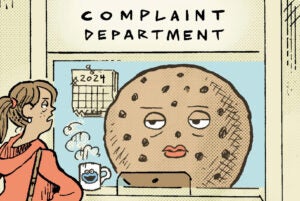The Alphabet C-suite faced a tougher grilling than usual during its quarterly earnings report on Tuesday.
The company is dealing with unlucky circumstances for its ad revenue numbers this quarter.
COVID rates were higher in August and September of last year, which kept people on their phones and streaming, creating tough year-over-year comparisons. And the growth of subscription services like YouTube TV and YouTube Premium shift revenue out of the advertising bucket while still contributing to the bottom line.
But Alphabet’s costs keep going up – the biggest source of new spending is data server centers – and advertisers are pulling back spend.
Ad revenue did tick up year over year, from $53.1 billion in Q3 2021 to $54.5 billion this year.
But there’s no mistaking the bad omens in Alphabet’s balance sheet. YouTube had a YoY decline in revenue for the first time since Alphabet started disclosing YouTube ad revenue two and a half years ago – and likely for the first time ever since YouTube was acquired. YouTube made $7.07 billion in ad revenue this quarter, compared to $7.21 billion in Q3 2021. Google Search revenue was also down sequentially – meaning it dropped from Q2 to Q3 this year. That’s only supposed to happen between Q4 and Q1.
Alphabet’s profitability plunged from almost $19 billion in Q3 2021 to a mere $13.9 billion this quarter. Obviously, nearly $14 billion is still a monster number, and that’s pure profit on $69 billion in revenue in Q3. But a $5 billion drop in net income caused investors to focus on Alphabet’s belt-tightening regime – when they weren’t anxiously inquiring about YouTube that is.
The Big Mac(ro) Attack!
Three months ago, when Alphabet CEO Sundar Pichai first laid out the company’s plans to freeze hiring and drop whole business units for a strategic internal review, one investor, Michael Nathanson of MoffettNathanson, asked, in so many words … why bother? Profit had slipped by $2.5 billion at that point, but companies like Snapchat that were making similar tough choices about headcount and investments had slipped from profitable to losing money, so were operating in true crisis mode.
This quarter, Nathansomn pressed Pichai on the company’s troubling rise in operational expenses. Financial chief Ruth Porat said investments were up largely due to data server costs, with the second-largest expenditure going to manufacturing of the new Pixel 6 phone. Phone production, at least, is a variable cost, not a fixed cost like data servers that will rack up every year.
Another investor asked whether the cuts and “focusing” of Alphabet’s investments, as Pichai called the restructuring, should be taken as a sign that executives expect choppy waters over the next six months to a year – or whether it’s part of a philosophical decision, which is how Pichai framed it during the call, rather than being a pure cost-conscious review.
Pichai’s response was that difficult economic moments help clarify the way forward. The 2008 and 2009 recession led to a belt-tightening phase at Google, he pointed out. But with that came a clearer focus on mobile as the opportunity for the next five to 10 years. He said that AI technology represents the same type of transformational growth opportunity.
Pichai told another investor that forecasting this potential economic downturn is less certain than previous dark periods. Which is a good thing, to be clear. Consumer spending isn’t going into hibernation, like in 2008, at least not yet. Inflation, the war in Ukraine and the coronavirus introduced a lot of fear and uncertainty for global investors, but are also bad vibes, as the kids would say.
Compare that to the direct impact on commerce when unemployment skyrocketed and homes were going into foreclosure right and left, and maybe we’re not in for such rough air this time around.
Another key difference, he said, is that Google Search has proven its mettle under the toughest of circumstances.
Apple might throw ITP and ATT at the ad industry; a pandemic can upend consumer behavior practically overnight; Facebook, Snapchat, the TV industry and even YouTube could be dropping in ad revenue.
Search is the only goose that never stops laying golden eggs.
“The strength of search as a product for users and for advertisers as a way to deliver ROI is great to see,” Pichai said.
Back to YouTube
Less great to see was the decline in YouTube’s revenue.
The advertiser pullback hit YouTube in particular this past quarter, said Alphabet Chief Business Officer Philipp Schindler. There were pullbacks in both direct response and brand advertising campaigns. App promo spending in particular was down as categories like DTC commerce apps and, especially, gaming apps, spent less this year.
Some ad revenue YouTube is happy to give up, like if people subscribe to its TV, music and ad-free viewing packages.
YouTube also has a runway in commerce, Schindler said, because it’s a platform for live commerce app campaigns and shoppable video units.
But the big priority for YouTube is to close the “monetization gap” between the majority of creator content and YouTube Shorts, its TikTok-like product for viral short videos
For now, though, revenue faces a headwind. Shorts content consumption is eating into the attention share of longer-form content that makes more money. Meta is experiencing a similar dynamic with its own TikTok clone, Reels.
“The initial progress on Shorts monetization has been encouraging, and we are focused on closing the monetization gap,” Schindler said.















